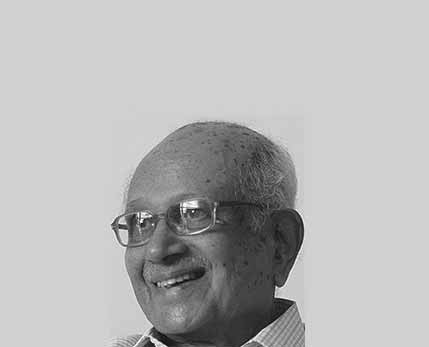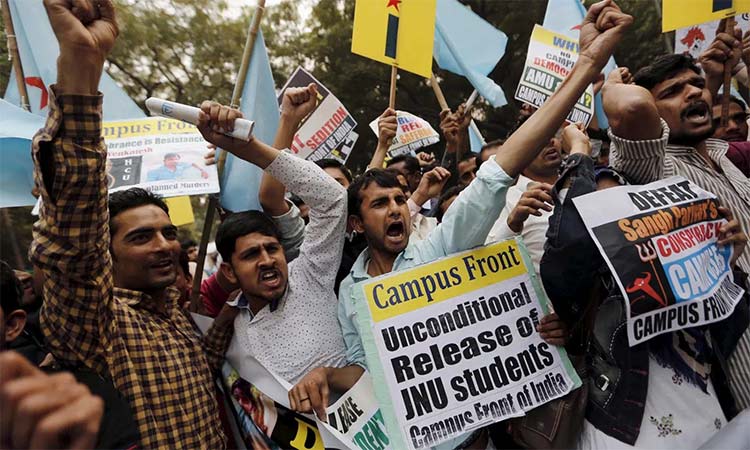Educational institutions still held to ransom

BRP Bhaskar@brpbhaskar
Indian journalist with over 50 years of newspaper, news agency and television experience.
25 Nov 2019

Students chant slogans for the release of their classmates.Wanton attacks on prestigious public educational institutions, which began soon after the Bharatiya Janata Party-led government came to power five years ago, are continuing. However, there appears to be a change in the strategy behind them.
Initially the attacks were led by the Akhil Bharatiya Vidyarthi Parishad (ABVP), student affiliate of the BJP’s ideological parent, the Rashtriya Swayamsevak Sangh.
Lately the leadership of the effort has been assumed by members who have been moved into key positions in the administrative bodies of the institutions.
The ABVP had played a big role in the growth of the Jana Sangh, the RSS’s first political vehicle, which merged its identity in the anti-Emergency coalition named the Janata Party, only to re-emerge later as the BJP.
The ABVP was the moving force behind the student agitations of the 1970s in Gujarat and Bihar. These movements received the blessings of freedom-fighter and Gandhian socialist Jayaprakash Narayan (JP), who imagined they could be the spearhead of the “total revolution” he had in mind.
JP’s endorsement enabled Jana Sangh leaders to earn respectability in the political arena which had eluded them in view of the party’s communal orientation.
Objections from the Socialist component of the Janata mixture to their continued RSS association forced the erstwhile Jana Sangh members to pull out and work under the BJP banner. While the strength of the other Janata components declined gradually, the BJP grew and became the national alternative to the Congress.
The two dirtiest words in the Hindutva lexicon are liberal and secular, the latter word often disdainfully rendered as ‘sickular’.
The BJP’s allergy to institutions like the Indian Institutes of Technology (IITs) and Jawaharlal Nehru University (JNU) arises from its perception that they are breeding grounds of liberal and secular thought. The ABVP was unable to make much headway in these institutions.
In Prime Minister Narendra Modi’s first term, the main targets were the JNU, the IIT at Chennai and the Central University of Hyderabad.
At JNU, the ABVP challenged the left-leaning bodies that controlled the elected Students Union. Police slapped sedition charges against a number of student leaders, including then JNUSU President Kanhaiya Kumar, after the ABVP accused them of raising pro-freedom slogans.
Najeeb Ahmed, a first year M.Sc (Biotechnology) student who disappeared after an assault by ABVP members three years ago, still remains untraced.
At the Chennai IIT and UoH, the ABVP’s targets were Dalit students propagating the ideals of Dr BR Ambedkar, Dalit icon and chief architect of the Indian Constitution. The surcharged atmosphere in the UoH campus led to the suicide of Rohit Vemula, a Dalit scholar.
Men placed by the BJP administration in key positions in institutions of higher learning are now the chief promoters of Hindutva’s objectives.
Recent events suggest that the drive against the elite institutions is aimed at restricting the entry of students from the weaker sections of society.
JNU Vice-Chancellor Jagadesh Kumar, himself a rural boy who made good, dismantled the inclusive and pluralistic policy which had enabled students from disadvantaged groups to access the institution.
As a result, the number of students from families earning not more than Rs 6,000 a month dropped from 48.4 per cent in 2016-17 to 28.2 per cent in 2017-18 and that of students with a rural background from 25.7 per cent to 9.8 per cent.
This year the JNU administration struck another blow on students by raising the hostel fees steeply. After the students protested, it offered to provide relief to those from families below the poverty line.
The students rejected the offer. Some reports have suggested that as many as 40 per cent of the students may be forced to drop out if the fee hike is not rolled back.
Shajahan Madampat, a social commentator, has accused the VC of building up an administrative team which is “said to be the who’s who of mediocrities in JNU’s otherwise outstanding academic community.”
A JNU alumnus, he says some of those pliant men and women were his contemporaries and he is writing with some personal knowledge.
The students’ agitation has split the faculty. The JNU Teachers Association, in talks with Central government officials, endorsed the students’ demand that the fee hike be rolled back. They also sought the VC’s resignation.
Later over 100 faculty members issued a statement dissociating themselves from the association.
Time is running out for the Centre to retrace its misguided social engineering project which is at work in JNU, realising it is harming the institution.
India

BRP Bhaskar@brpbhaskar
Indian journalist with over 50 years of newspaper, news agency and television experience.
25 Nov 2019

Students chant slogans for the release of their classmates.Wanton attacks on prestigious public educational institutions, which began soon after the Bharatiya Janata Party-led government came to power five years ago, are continuing. However, there appears to be a change in the strategy behind them.
Initially the attacks were led by the Akhil Bharatiya Vidyarthi Parishad (ABVP), student affiliate of the BJP’s ideological parent, the Rashtriya Swayamsevak Sangh.
Lately the leadership of the effort has been assumed by members who have been moved into key positions in the administrative bodies of the institutions.
The ABVP had played a big role in the growth of the Jana Sangh, the RSS’s first political vehicle, which merged its identity in the anti-Emergency coalition named the Janata Party, only to re-emerge later as the BJP.
The ABVP was the moving force behind the student agitations of the 1970s in Gujarat and Bihar. These movements received the blessings of freedom-fighter and Gandhian socialist Jayaprakash Narayan (JP), who imagined they could be the spearhead of the “total revolution” he had in mind.
JP’s endorsement enabled Jana Sangh leaders to earn respectability in the political arena which had eluded them in view of the party’s communal orientation.
Objections from the Socialist component of the Janata mixture to their continued RSS association forced the erstwhile Jana Sangh members to pull out and work under the BJP banner. While the strength of the other Janata components declined gradually, the BJP grew and became the national alternative to the Congress.
The two dirtiest words in the Hindutva lexicon are liberal and secular, the latter word often disdainfully rendered as ‘sickular’.
The BJP’s allergy to institutions like the Indian Institutes of Technology (IITs) and Jawaharlal Nehru University (JNU) arises from its perception that they are breeding grounds of liberal and secular thought. The ABVP was unable to make much headway in these institutions.
In Prime Minister Narendra Modi’s first term, the main targets were the JNU, the IIT at Chennai and the Central University of Hyderabad.
At JNU, the ABVP challenged the left-leaning bodies that controlled the elected Students Union. Police slapped sedition charges against a number of student leaders, including then JNUSU President Kanhaiya Kumar, after the ABVP accused them of raising pro-freedom slogans.
Najeeb Ahmed, a first year M.Sc (Biotechnology) student who disappeared after an assault by ABVP members three years ago, still remains untraced.
At the Chennai IIT and UoH, the ABVP’s targets were Dalit students propagating the ideals of Dr BR Ambedkar, Dalit icon and chief architect of the Indian Constitution. The surcharged atmosphere in the UoH campus led to the suicide of Rohit Vemula, a Dalit scholar.
Men placed by the BJP administration in key positions in institutions of higher learning are now the chief promoters of Hindutva’s objectives.
Recent events suggest that the drive against the elite institutions is aimed at restricting the entry of students from the weaker sections of society.
JNU Vice-Chancellor Jagadesh Kumar, himself a rural boy who made good, dismantled the inclusive and pluralistic policy which had enabled students from disadvantaged groups to access the institution.
As a result, the number of students from families earning not more than Rs 6,000 a month dropped from 48.4 per cent in 2016-17 to 28.2 per cent in 2017-18 and that of students with a rural background from 25.7 per cent to 9.8 per cent.
This year the JNU administration struck another blow on students by raising the hostel fees steeply. After the students protested, it offered to provide relief to those from families below the poverty line.
The students rejected the offer. Some reports have suggested that as many as 40 per cent of the students may be forced to drop out if the fee hike is not rolled back.
Shajahan Madampat, a social commentator, has accused the VC of building up an administrative team which is “said to be the who’s who of mediocrities in JNU’s otherwise outstanding academic community.”
A JNU alumnus, he says some of those pliant men and women were his contemporaries and he is writing with some personal knowledge.
The students’ agitation has split the faculty. The JNU Teachers Association, in talks with Central government officials, endorsed the students’ demand that the fee hike be rolled back. They also sought the VC’s resignation.
Later over 100 faculty members issued a statement dissociating themselves from the association.
Time is running out for the Centre to retrace its misguided social engineering project which is at work in JNU, realising it is harming the institution.
India